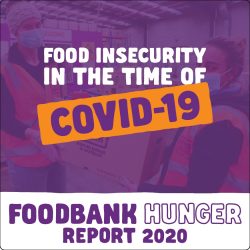Foodbank bracing for a further rise in hunger
12th OCTOBER 2020: Foodbank, Australia’s leading food relief organisation, today reported that demand for food relief is up and believes it has not yet seen ‘peak hunger’ in the COVID-19 crisis.
The organisation today published a special edition of its annual Foodbank Hunger Report which revealed that, while government assistance measures such as JobSeeker and JobKeeper have provided much needed temporary relief, charities and food insecure Australians alike have an extreme sense of unease about the future as these measures are rolled back. More than one in three (35%) food insecure Australians receiving benefits don’t know how they will cope or expect they will not cope well at all.
Foodbank Australia CEO, Brianna Casey, said this year’s report emphasises that COVID-19 is having a profound effect on the food security of Australians. “The report highlights that, while need for food relief has become somewhat erratic and unpredictable, charities are reporting that overall demand is up by 47% and many of those now experiencing food insecurity (28%) have never before needed support,” Casey explained.
People seeking assistance at least once a week have more than doubled since last year (from 15% to 31%). “Those who were already struggling before coronavirus hit have been impacted more quickly and seriously than others as they have lower resilience against life’s turbulence,” Casey commented.
“In addition, we are seeing new groups reach out for help, in particular casual workers and international students. These individuals tend to be younger, so it’s not surprising that our report shows it’s Australia’s youth who are bearing the brunt of COVID-19. They are going without food more often than any other age group with 65% of food insecure Gen Z (aged 18-25) going hungry at least once a week compared to 25% of food insecure Baby Boomers (56-74) and 25% of Builders (75+).”
Now in its eighth year, the Foodbank Hunger Report brings together research between April and August undertaken with both charities and individuals experiencing food insecurity.
Key Statistics
- Charities are seeing overall demand up by an average of 47%.
- The proportion of food insecure Australians seeking food relief at least once a week has more than doubled since last year, from 15% to 31%.
- When it comes to COVID-19 causing hunger in the community, young Australians are being hit the hardest. 65% of food insecure 18 to 25-year-olds are going without food at least once a week due to the pandemic.
- More than a quarter (28%) of those experiencing food insecure had never faced it before the pandemic.
- Charities are seeing significant numbers of two new groups in particular: casual employees and international students.
- 43% of food insecure Australians are going a whole day a week without eating vs 30% in 2019.
- 61% of food secure Australians have accessed food relief since COVID-19 hit but the other 40% have not reached out for the help they need. The most common barriers to accessing relief are embarrassment (33%), shame (30%) or thinking there might be others in greater need (33%).
- While government assistance, such as JobKeeper and JobSeeker, have provided vital temporary relief for many, 62% say they are not receiving the assistance they need.
- 37% say they need more than they’re getting,
- 21% are ineligible for any additional support and
- 4% have found it too difficult to apply
- Post-COVID-19, almost 35% of food secure Australians don’t know how they will cope or expect they won’t cope at all when the additional government support is withdrawn.
 Contact us
Contact us Log in
Log in
